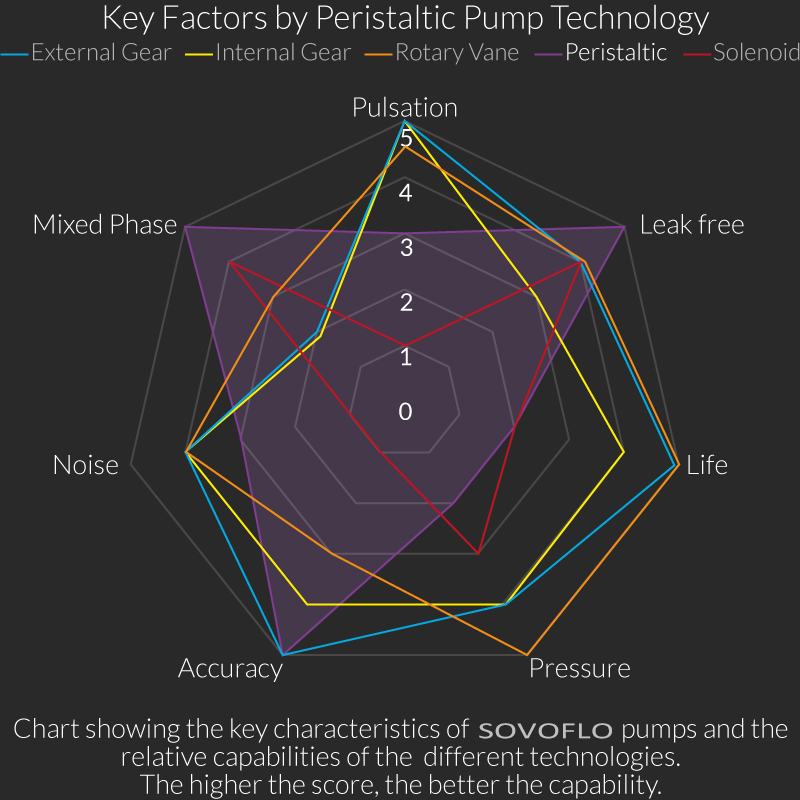peristaltic pump PERISTALTIC PUMPS
peristaltic pump
competitive advantage
Overview
peristaltic pump does not contact the fluid, which is in the pump tube.
can maintain fluid safety at all times and can achieve high accuracy, making it an ideal choice for food, pharmaceutical and analytical applications.
advantage
Fast pipe change and short downtime
positive displacement technology, flow is proportional to speed
Excellent suction capacity
Dry turning ability
without seals
resistance to suspended small particles
reversible
application industry
- measurement
- conveying
- environment
- Catering
- Medical
- Paints and Inks
- Technology
- water treatment
- Other Industries
is used
- measurement
- conveying
- special applications
contrast
compared with the diaphragm pump,peristaltic pump features:
- reversible
Compared with centrifugal pump,peristaltic pump features:
- Dry Turn
- can be flipped
- low energy consumption
PERISTALTIC PUMPS
What is a peristaltic pump?
A peristaltic pump is part of the worldpositive-displacement pumps, I .e. all those types of pumps that exploit the volume variation in a pump chamber to move and pressurize a fluid. In positive-displacement pumps, the flow rate is always directly proportional to the speed.
The structure of the pump is free from valves, seals, and glands, thus offeringimproved design and easier maintenance. They are suitable for different flow ranges and liquid types.
This technology, regardless of size, is able to continuously pump the fluidwithout interruptions and without coming into contact with it, creating perfect isolation between the fluid and the pump.
Because of its nature, the peristaltic pumps can produce pulsations. This happens when the flow rate is not constant. Usually, a higher number of rollers can reduce the flow rate thus limiting pulsation.
How does a peristaltic pump work?
Principle of operation of peristaltic pumps: peristaltic pumps use the principle of peristalsis, whereby the alternating deformation and compression of a soft hose transports the fluid. This is done by means of a rotating roller that deforms the hose:
• the pump is made of a rotor presenting one or more rotating rollers on its circumference that occlude an elastic hose (made of silicone, PVC, or other polymers)
• the hose can also be compatible with solvents, inks and paints, and other types of fluids
• the roller compresses the hose offering fluid suction capabilities
• this creates a vacuum that forces the fluid to move toward the outlet
• once the roller is passed, the hose regains its original shape and dimension
The liquidnever enters into contact with other parts of the peristaltic pumpbut exclusively with the hose. This means that the pump guaranteesbetter sealingand alonger-lasting lifecycle, which is due to the prevention of possible damage to internal elements caused by corrosive or chemical substances.
Finally, thanks to itsself-priming design, this pump is able to occlude the hose with its rotating roller thus blocking the fluid from flowing back.
Main applications of peristaltic pumps
Peristaltic pumps, due to their design, are ideal for all applications wherethe fluid needs to be dosed with precisionand any possibility of contamination must be excluded, such as for food, medical, and analytical applications.
•Inmedical field, peristaltic pumps are perfect thanks to their compatibility with fluids of different natures and viscosities. Thus, when using corrosive or chemical liquids, the risks of leakage or damage to the pump are limited. On the contrary, resorting to the peristaltic principle, it is possible to obtain excellent results in this field.
• Thanks to the precision and complete separation between the liquid and the pump, peristaltic pumps find widespread use even in those fields that operate in close contactinks, enamels, glues, and paints.
•water treatment-related applications, peristaltic pumps are useful because they're suitable not only with chemical substances used in these treatments but also with liquids that are dense or contain suspended solids, without any risk of damage.
• Finally,food and beverage fieldalso resorts to the peristaltic principle of these pumps for product pumping, transferring, and dosing purposes (such as with several beverages).
Advantages and disadvantages of peristaltic pumps

|
|
| the tubeis the only part of the pump that wears out and can be changed rapidly |
| excellentsuction capabilities |
| tolerance to small particlesin suspension |
| the lack of valves and seals/gaskets meansless maintenance |
| self-priming design |
| peristaltic pumps can handlecorrosive and slightly viscous fluids |
| can also be useddelicate fluids. The dispensing is gentle thanks to the low shear forces, making them suitable for use with cutting-sensitive fluids |
| lower backflow and siphoning |
| peristaltic pumps areeasy to clean and sterilize, thus guaranteeing zero contamination |
| dry operationis possible under certain conditions without damage |
| reversibility |
|
|
| due to the variability of the tubing, the pump systemmust be calibratedto reach an acceptable accuracy |
| due to wearingtubing must be changedover time |
| if used extensively or without replacement,tube may leak |
| aslight pulsationis unavoidable during the operation but can be reduced with the latest peristaltic pump technologies |
| flow rate is sensitiveto changes in differential pressure conditions |
| liquid viscosity might reduce the effectiveness of peristaltic pumps |


